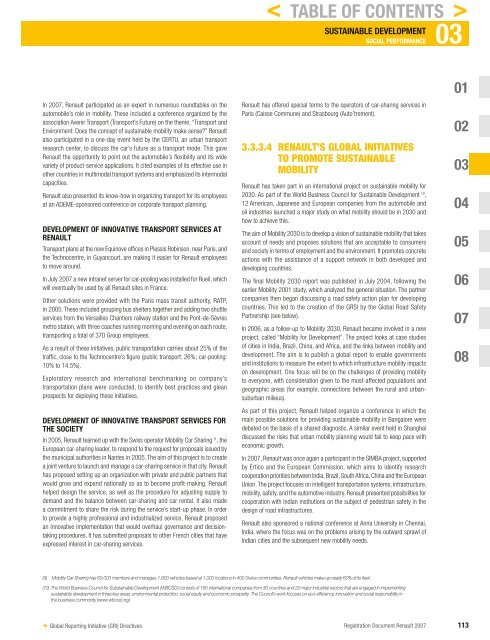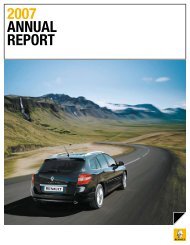2007 Interactive Registration Document - Renault
2007 Interactive Registration Document - Renault
2007 Interactive Registration Document - Renault
Create successful ePaper yourself
Turn your PDF publications into a flip-book with our unique Google optimized e-Paper software.
In <strong>2007</strong>, <strong>Renault</strong> participated as an expert in numerous roundtables on the<br />
automobile’s role in mobility. These included a conference organized by the<br />
association Avenir Transport (Transport’s Future) on the theme, “Transport and<br />
Environment: Does the concept of sustainable mobility make sense?” <strong>Renault</strong><br />
also participated in a one-day event held by the CERTU, an urban transport<br />
research center, to discuss the car’s future as a transport mode. This gave<br />
<strong>Renault</strong> the opportunity to point out the automobile’s fl exibility and its wide<br />
variety of product-service applications. It cited examples of its effective use in<br />
other countries in multimodal transport systems and emphasized its intermodal<br />
capacities.<br />
<strong>Renault</strong> also presented its know-how in organizing transport for its employees<br />
at an ADEME-sponsored conference on corporate transport planning.<br />
DEVELOPMENT OF INNOVATIVE TRANSPORT SERVICES AT<br />
RENAULT<br />
Transport plans at the new Equinove offi ces in Plessis Robinson, near Paris, and<br />
the Technocentre, in Guyancourt, are making it easier for <strong>Renault</strong> employees<br />
to move around.<br />
In July <strong>2007</strong> a new intranet server for car-pooling was installed for Rueil, which<br />
will eventually be used by all <strong>Renault</strong> sites in France.<br />
Other solutions were provided with the Paris mass transit authority, RATP,<br />
in 2005. These included grouping bus shelters together and adding two shuttle<br />
services from the Versailles Chantiers railway station and the Pont-de-Sèvres<br />
metro station, with three coaches running morning and evening on each route,<br />
transporting a total of 370 Group employees.<br />
As a result of these initiatives, public transportation carries about 25% of the<br />
traffi c, close to the Technocentre’s fi gure (public transport: 26%; car-pooling:<br />
10% to 14.5%).<br />
Exploratory research and international benchmarking on company’s<br />
transportation plans were conducted, to identify best practices and glean<br />
prospects for deploying these initiatives.<br />
DEVELOPMENT OF INNOVATIVE TRANSPORT SERVICES FOR<br />
THE SOCIETY<br />
In 2005, <strong>Renault</strong> teamed up with the Swiss operator Mobility Car Sharing 9 , the<br />
European car-sharing leader, to respond to the request for proposals issued by<br />
the municipal authorities in Nantes in 2005. The aim of this project is to create<br />
a joint venture to launch and manage a car-sharing service in that city. <strong>Renault</strong><br />
has proposed setting up an organization with private and public partners that<br />
would grow and expand nationally so as to become profi t-making. <strong>Renault</strong><br />
helped design the service, as well as the procedure for adjusting supply to<br />
demand and the balance between car-sharing and car rental. It also made<br />
a commitment to share the risk during the service’s start-up phase. In order<br />
to provide a highly professional and industrialized service, <strong>Renault</strong> proposed<br />
an innovative implementation that would overhaul governance and decisiontaking<br />
procedures. It has submitted proposals to other French cities that have<br />
expressed interest in car-sharing services.<br />
✦ Global Reporting Initiative (GRI) Directives<br />
< TABLE OF CONTENTS ><br />
SUSTAINABLE DEVELOPMENT 03<br />
SOCIAL PERFORMANCE<br />
<strong>Renault</strong> has offered special terms to the operators of car-sharing services in<br />
Paris (Caisse Commune) and Strasbourg (Auto’trement).<br />
3.3.3.4 RENAULT’S GLOBAL INITIATIVES<br />
TO PROMOTE SUSTAINABLE<br />
MOBILITY<br />
<strong>Renault</strong> has taken part in an international project on sustainable mobility for<br />
2030. As part of the World Business Council for Sustainable Development 10 ,<br />
12 American, Japanese and European companies from the automobile and<br />
oil industries launched a major study on what mobility should be in 2030 and<br />
how to achieve this.<br />
The aim of Mobility 2030 is to develop a vision of sustainable mobility that takes<br />
account of needs and proposes solutions that are acceptable to consumers<br />
and society in terms of employment and the environment. It promotes concrete<br />
actions with the assistance of a support network in both developed and<br />
developing countries.<br />
The fi nal Mobility 2030 report was published in July 2004, following the<br />
earlier Mobility 2001 study, which analyzed the general situation. The partner<br />
companies then began discussing a road safety action plan for developing<br />
countries. This led to the creation of the GRSI by the Global Road Safety<br />
Partnership (see below).<br />
In 2006, as a follow-up to Mobility 2030, <strong>Renault</strong> became involved in a new<br />
project, called “Mobility for Development”. The project looks at case studies<br />
of cities in India, Brazil, China, and Africa, and the links between mobility and<br />
development. The aim is to publish a global report to enable governments<br />
and institutions to measure the extent to which infrastructure mobility impacts<br />
on development. One focus will be on the challenges of providing mobility<br />
to everyone, with consideration given to the most-affected populations and<br />
geographic areas (for example, connections between the rural and urbansuburban<br />
milieus).<br />
As part of this project, <strong>Renault</strong> helped organize a conference in which the<br />
main possible solutions for providing sustainable mobility in Bangalore were<br />
debated on the basis of a shared diagnostic. A similar event held in Shanghaï<br />
discussed the risks that urban mobility planning would fail to keep pace with<br />
economic growth.<br />
In <strong>2007</strong>, <strong>Renault</strong> was once again a participant in the SIMBA project, supported<br />
by Ertico and the European Commission, which aims to identify research<br />
cooperation priorities between India, Brazil, South Africa, China and the European<br />
Union. The project focuses on intelligent transportation systems, infrastructure,<br />
mobility, safety, and the automotive industry. <strong>Renault</strong> presented possibilities for<br />
cooperation with Indian institutions on the subject of pedestrian safety in the<br />
design of road infrastructures.<br />
<strong>Renault</strong> also sponsored a national conference at Anna University in Chennai,<br />
India, where the focus was on the problems arising by the outward sprawl of<br />
Indian cities and the subsequent new mobility needs.<br />
(9 ) Mobility Car Sharing has 60,000 members and manages 1,800 vehicles based at 1,000 locations in 400 Swiss communities. <strong>Renault</strong> vehicles make up nearly 60% of its fleet.<br />
(10 ) The World Business Council for Substainable Development (WBCSD) consists of 180 international companies from 30 countries and 20 major industrial sectors that are engaged in implementing<br />
sustainable sustainable development development in three key areas: environmental environmental protection, protection, social equity and economic prosperity. prosperity. The The Council’s Council’s work work focuses on eco-efficiency, eco-efficiency, innovation and social responsibility responsibility in in<br />
the business community (www.wbcsd.org).<br />
01<br />
02<br />
03<br />
04<br />
05<br />
06<br />
07<br />
08<br />
<strong>Registration</strong> <strong>Document</strong> <strong>Renault</strong> <strong>2007</strong> 113




